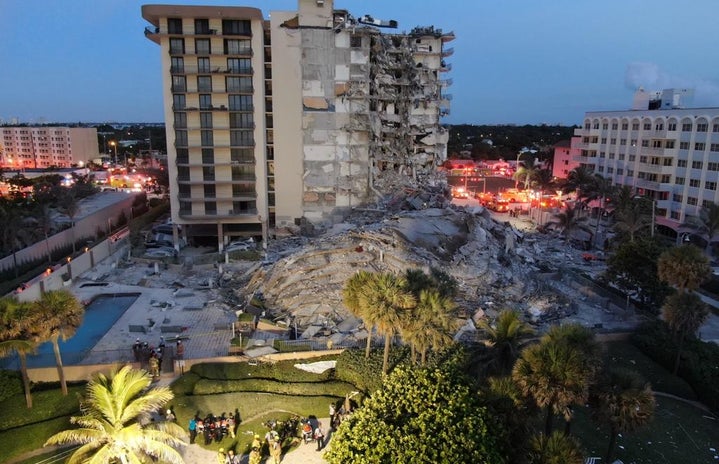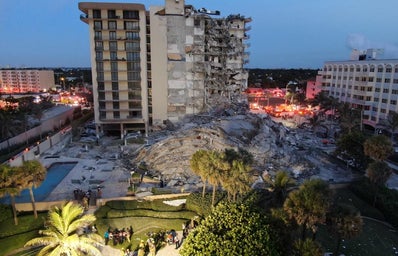On June 24, the Champlain Towers South in Surfside, Florida in Miami-Dade County collapsed, leaving hundreds either instantaneously dead or severely injured. The death toll is currently 64, but there are still 76 missing people that remain unaccounted for as firefighters continue to sift through the rubble for residents’ loved ones. On July 7, officials transitioned from search and rescue to search and recovery, presuming all missing victims to be dead. Though the true root of the disaster is still unclear, it is speculated that the collapse was fueled by ignored risks and “missed warnings” concerning the structural integrity of the building, and there is a newfound concern that other buildings in the Miami area may also be at risk of collapse due to rising sea levels and other indicators of climate change.
Experts are currently divided on whether the collapse was solely due to structural damage or the effects of sea levels rising due to climate change — or, some argue that perhaps the disaster was because of a combination of both. In 2018, an engineer found that a slab under the pool deck area was not sloped to drain adequately and had thus become damaged, weakening the infrastructure. Although the engineer urged that this issue needed to immediately be fixed, it was disregarded. And a 2020 study discovered that the Champlain Towers South were sinking at a rate of about 2 millimeters per year between 1993 and 1999. Though it has not yet been thoroughly investigated nor deduced, it is safe to assume that the incident likely did involve the repercussions of climate change.
Climate change-fueled crises like the devastating one in Miami are not new. On July 3, the ocean caught on fire in Mexico due to a gas pipeline fire. Numerous environmental experts began to point out the persistent dangers of the fossil fuel industry — fossil fuels such as gas contribute to polluting the environment, ultimately playing a role in fast-forwarding human-induced climate change. Hot temperatures across the globe have been plaguing communities, with 180 wildfires burning across Canada due to a massive heat wave. And yet despite all of these concerning events, there seems to be little systemic change to prevent future disasters.
There is a newfound concern that other buildings in the Miami area may also be at risk of collapse due to rising sea levels and other indicators of climate change.
Though the investigation of the cause of the Miami collapse is ongoing, it nevertheless sheds a light on the growing concern of climate change that is being persistently ignored by authorities. Rising sea levels due to climate change has been an ignored concern by luxury building developers in South Florida for years now. Albert Slap, the chief executive of RiskFootprint, spoke to The Washington Post, explaining that “the mix of swelling groundwater and tidal cycles juiced by climate change means coastal buildings and their concrete foundations spend more time in water than they did in the past.” Despite expanding research and warnings on the harms of climate change, luxury real estate tycoons are too concerned about making a profit rather than prioritizing the safety of citizens, and especially citizens of color and lower-income communities in Miami. There is a huge wealth gap in Miami, with 5% of the United States’ billionaires presiding there, yet 40% of the county identify as working poor.
Generally, the effects of climate change tend to disproportionately harm lower-income communities and communities of color. For instance, a 2009 report conducted by the University of Southern California on the American climate gap stated that “African American Los Angeles residents have a projected heat-wave mortality rate that is nearly twice that of the Los Angeles average.” Moreover, five of the smoggiest cities in California have the highest amounts of lower income people and people of color. Though this study is only focused on the implications of climate change on these communities in California, there is other evidence that proves that this is a systemic issue.
Scientists have been urging that the global climate crisis is grave, and that serious changes need to be made over the next 10 years. According to the IPPC (Intergovernmental Panel on Climate Change), the world’s carbon emissions need to be reduced by 45% by 2030 to keep the earth’s average temperature below pre-industrial levels. If it warms more, scientific experts predict that ecosystems across the globe will begin to destruct — and who knows what else will happen?
Despite growing substantial evidence and countless catastrophic climate events that reveal the detrimental effects of global climate change, little has been done to prevent and stop it. Billion-dollar companies and wealthy business moguls like the luxury real estate developers in Miami also do not care enough to put a halt to the issue, as they are not the ones directly affected by the widespread detriments of climate change. Unfortunately, the media does not do much to help with the problem either; a huge climate change-induced environmental disaster will happen, there will be discussion of the direness of climate change in the news, and then the conversation dwindles within a few days. It is a vicious cycle that has been happening for decades. We need to keep the conversation going, and hold these companies and individuals accountable for the widespread consequences of their actions.
Studies Cited:
Morello-Frosch, Rachel, Ph.D., MPH, et al. The Climate Gap: Inequalities in How Climate Change Hurts Americans & How to Close the Gap.


